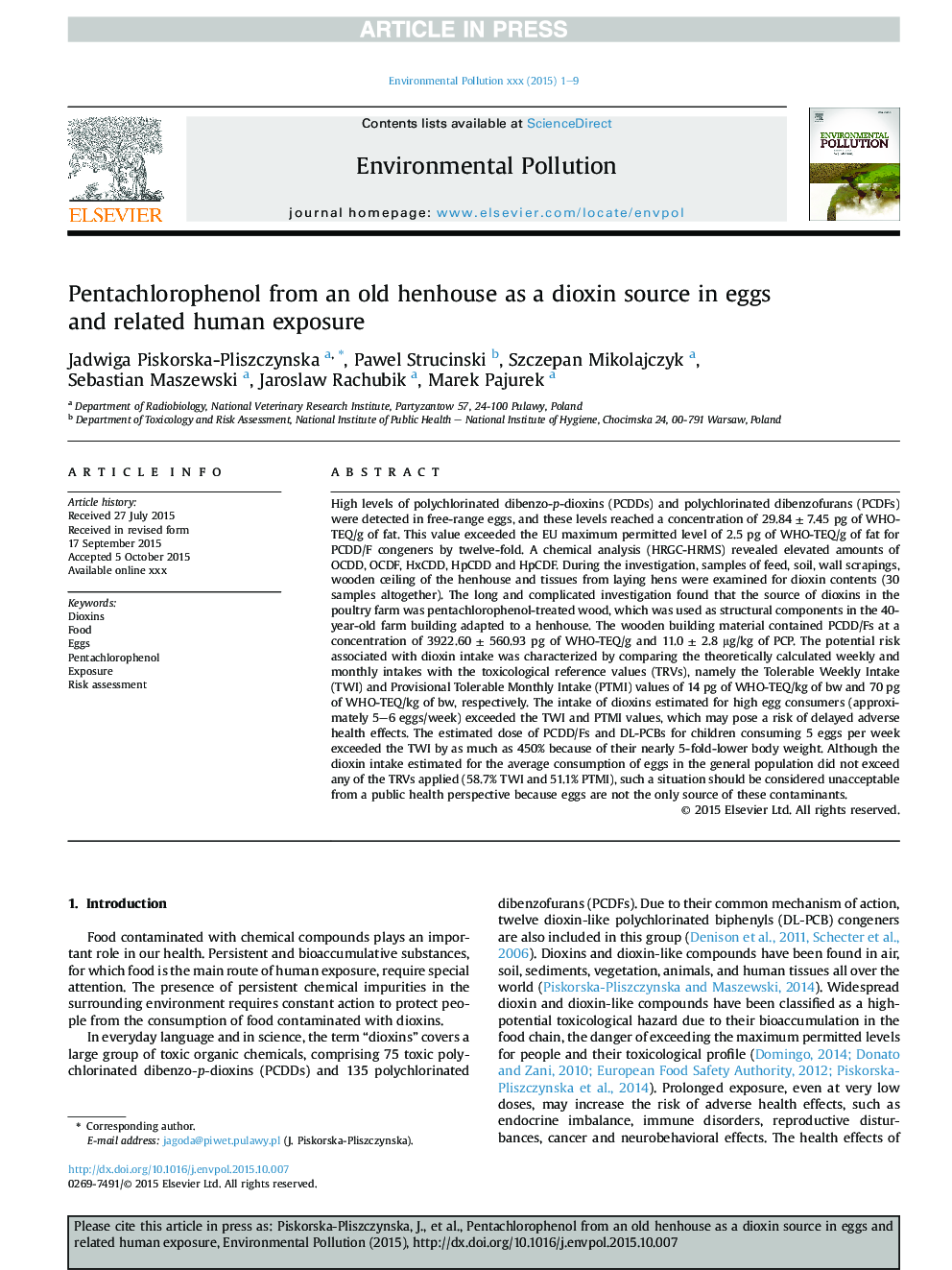| کد مقاله | کد نشریه | سال انتشار | مقاله انگلیسی | نسخه تمام متن |
|---|---|---|---|---|
| 6316249 | 1309044 | 2016 | 9 صفحه PDF | دانلود رایگان |
عنوان انگلیسی مقاله ISI
Pentachlorophenol from an old henhouse as a dioxin source in eggs and related human exposure
ترجمه فارسی عنوان
پنتا کلروفنل از یک گوسفند قدیمی به عنوان یک منبع دیوکسین در تخم مرغ و قرار گرفتن در معرض انسانی مربوط به آن
دانلود مقاله + سفارش ترجمه
دانلود مقاله ISI انگلیسی
رایگان برای ایرانیان
کلمات کلیدی
دیوکسین ها، غذا، تخم مرغ، پنتا کلروفنل، گرفتن در معرض، ارزیابی ریسک،
موضوعات مرتبط
علوم زیستی و بیوفناوری
علوم محیط زیست
شیمی زیست محیطی
چکیده انگلیسی
High levels of polychlorinated dibenzo-p-dioxins (PCDDs) and polychlorinated dibenzofurans (PCDFs) were detected in free-range eggs, and these levels reached a concentration of 29.84 ± 7.45 pg of WHO-TEQ/g of fat. This value exceeded the EU maximum permitted level of 2.5 pg of WHO-TEQ/g of fat for PCDD/F congeners by twelve-fold. A chemical analysis (HRGC-HRMS) revealed elevated amounts of OCDD, OCDF, HxCDD, HpCDD and HpCDF. During the investigation, samples of feed, soil, wall scrapings, wooden ceiling of the henhouse and tissues from laying hens were examined for dioxin contents (30 samples altogether). The long and complicated investigation found that the source of dioxins in the poultry farm was pentachlorophenol-treated wood, which was used as structural components in the 40-year-old farm building adapted to a henhouse. The wooden building material contained PCDD/Fs at a concentration of 3922.60 ± 560.93 pg of WHO-TEQ/g and 11.0 ± 2.8 μg/kg of PCP. The potential risk associated with dioxin intake was characterized by comparing the theoretically calculated weekly and monthly intakes with the toxicological reference values (TRVs), namely the Tolerable Weekly Intake (TWI) and Provisional Tolerable Monthly Intake (PTMI) values of 14 pg of WHO-TEQ/kg of bw and 70 pg of WHO-TEQ/kg of bw, respectively. The intake of dioxins estimated for high egg consumers (approximately 5-6 eggs/week) exceeded the TWI and PTMI values, which may pose a risk of delayed adverse health effects. The estimated dose of PCDD/Fs and DL-PCBs for children consuming 5 eggs per week exceeded the TWI by as much as 450% because of their nearly 5-fold-lower body weight. Although the dioxin intake estimated for the average consumption of eggs in the general population did not exceed any of the TRVs applied (58.7% TWI and 51.1% PTMI), such a situation should be considered unacceptable from a public health perspective because eggs are not the only source of these contaminants.
ناشر
Database: Elsevier - ScienceDirect (ساینس دایرکت)
Journal: Environmental Pollution - Volume 208, Part B, January 2016, Pages 404-412
Journal: Environmental Pollution - Volume 208, Part B, January 2016, Pages 404-412
نویسندگان
Jadwiga Piskorska-Pliszczynska, Pawel Strucinski, Szczepan Mikolajczyk, Sebastian Maszewski, Jaroslaw Rachubik, Marek Pajurek,
